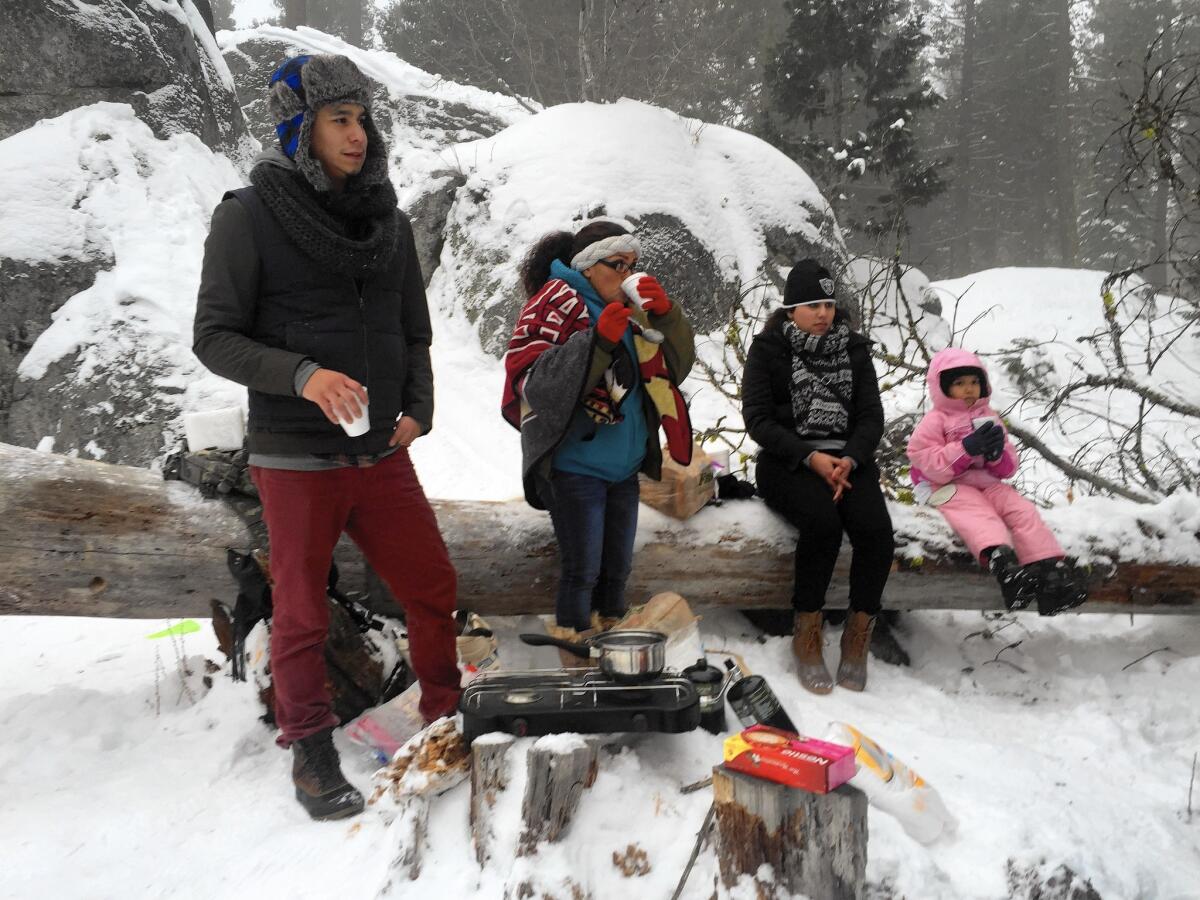After years of California drought, playing in the snow is a delight

- Share via
reporting from SHAVER LAKE, Calif — Savannah Mayorga, 5, was born in a dry year.
“We didn’t know then how dry it was, that it was the beginning of the drought,” said her father, Robert Mayorga.
This week she sat on a log, a padded pink pumpkin in a snowsuit her parents bought her years ago but that had never been worn because there wasn’t snow.
The clouds hung low and heavy, the sky and hills both white. Dozens of families crunched, slipped and skidded across snow. Their polka-dotted sweaters, pompom hats and crayon-colored ski jackets reflected in the icy lake.
Children slid down every bump and rise on inexpensive plastic discs or sleds. It seemed to start off with one child per sled, but as piles of broken sled-shards grew higher, the number of children per sled increased. A dog scratched at the snow and came up with an old carrot that surely had been a snowman’s nose.
The crowd that gets new ski boots and snowboards for Christmas was at higher-elevation resorts. These were locals from Fresno and Dinuba, Sanger and Selma, who drove up for the day and frolicked within sight of the parking lot. These were people whose livelihoods most depend on the Sierra snowpack.
Over the past five years, Mayorga, 49, went from pruning grapevines to working in nut orchards as table grapes gave way to higher-dollar crops that could make a profit with more expensive water.
Field work dried up and families moved away. Mayorga’s father, Acecion, a farm worker contractor in the tiny community of San Joaquin, lost contracts because he didn’t have enough workers to pick the grapes that were left.
“There hasn’t been much Christmas in places like San Joaquin for years,” Robert Mayorga said.
Water and Power is The Times’ guide to the drought. Sign up to get the free newsletter >>
For four winters, once snow-capped peaks were mostly bare. Last spring the Sierra Nevada snowpack was at a 500-year low. In a typical year that snowpack provides California with about a third of its water supply.
So when Mayorga’s son, Robert Jr., told him that snow was in the forecast over the holidays, the family started planning a big trip.
“The snow is the water that is the work. The whole Central Valley depends on it,” Robert Mayorga said. “If there was snow, then, well, man, I wanted to see it for myself.”
By Monday, a series of storms had brought the snow level above average for December. There was more Sierra snow than at any time in two years. Mayorga and his kids and grandkids, in-laws and friends played in snow at Shaver Lake, elevation 5,500 feet.
High December snowpack doesn’t always mean it will be a good snow year. But Mayorga figured it was a start.
His entire clan was outfitted in new, warm clothes — Christmas presents from Robert Jr. He used to work at Yosemite National Park in the summers, but when the Merced River dipped low, job openings did, too. He moved to Oakland to go to college and tend bar. His tips had bought his half brother Angel a hat with furry ear-flaps, scarves for everyone and boots for those who didn’t already have them.
Mayorga used a propane camping stove to make hot cider and cocoa. His son-in-law brought out the family’s beaten-up, old Smokey Joe to grill hot dogs, hot links and two kinds of chicken — spicy and not-as-spicy.
By late afternoon, most of the families at the lake had children changing into warm clothes in the back seats of their cars for the ride down the hill.
But Mayorga and his family stayed. They watched the sunset over the icy lake and built a little campfire.
“We were the last ones out there. It was beautiful. We had so much fun. But most important was the snow. It kind of gave me some hope,” he said. “And hope is all we got.”
Twitter: @dianamarcum
MORE: Get our best stories in your Facebook feed >>
ALSO
In downtrodden San Bernardino, immigrants find a place to start
L.A. County jail inmates were handcuffed to a wall for hours on ‘potty watch’
4.4 quake, aftershocks strikes San Bernardino County







